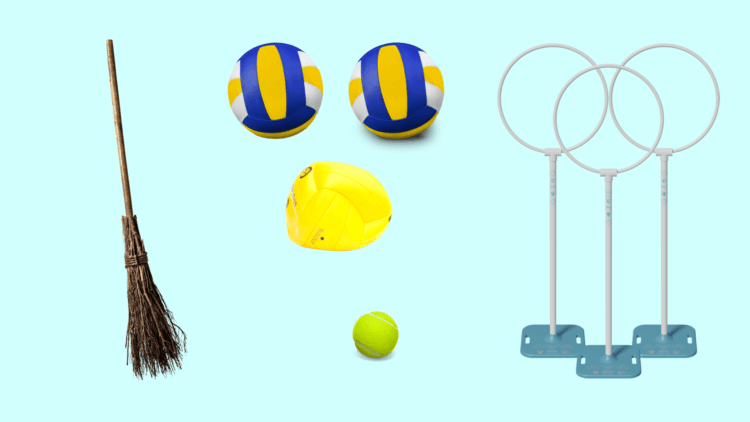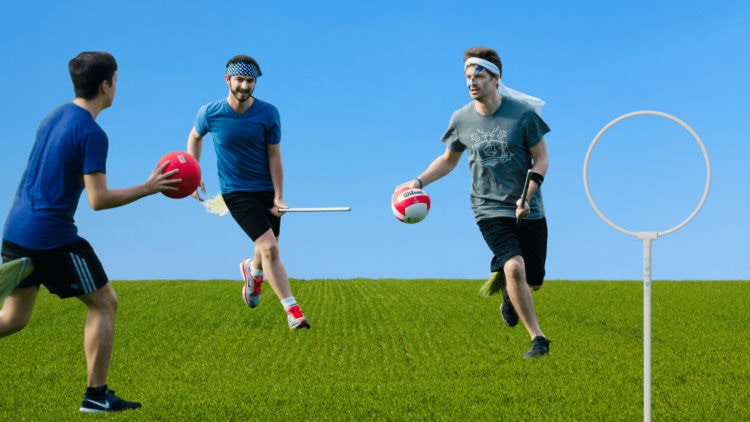
OBJECTIVE OF QUIDDITCH: Score more points than the opposing team by throwing or kicking a ball through one of three hoops and catching the “golden snitch”.
NUMBER OF PLAYERS: 14 players, 7 per team
MATERIALS: 6 “hoops”, 1 broomstick per player, 1 volleyball, 3 dodgeballs, a tennis ball or waistband flag, colored headbands
TYPE OF GAME: Sport
AUDIENCE: 7+
OVERVIEW OF QUIDDITCH
Quidditch, a sport adapted from the widely popular Harry Potter franchise, sees players run around a field while holding a broomstick between their legs. Besides the broomsticks, the surprisingly physical game of Quidditch is incredibly unique regarding the different player positions, with all four roles having very different objectives.
SETUP

POSITIONS
Seven players make up a Quidditch team: three chasers, two beaters, one keeper, and one seeker. While the goal is to ultimately score the most points, each of these positions holds unique roles.
- Chasers: These players are primarily responsible for throwing the ball through any of the opposing team’s three hoops. These players are often identified by their white headbands.
- Beaters: Fundamentally the “bullies” of the game, beaters are allowed to throw bludgers (dodgeballs) at the opposing team. If hit with a bludger, the opposing player must drop any balls they hold, remove their broomstick, and touch their own hoops to re-enter play. While still subject to being hit by bludgers, beaters are the only position allowed to catch bludgers from the opposing team, saving themselves or other players from being “knocked off” their broomsticks. These players often wear black headbands.
- Keepers: A keeper’s job is akin to a goalie working to prevent balls from entering their team’s hoops. Keepers can make physical contact with opposing chasers and can act as a team’s fourth chaser if necessary. These players are identified with a green headband.
- Seekers: Seekers have a unique role in the game: catch the golden snitch. This “golden snitch” is a neutral player who runs around with a tennis ball or flag attached to their waistband. Seekers are not allowed to enter the game until the golden snitch is “released” 17 minutes into the game. Seekers often wear a yellow headband.
THE GOLDEN SNITCH
The golden snitch is a neutral player with a tennis ball or flag attached to their waistband. This player, along with the seekers attempting to catch them, are allowed to leave the playing field entirely—that is, they’re allowed to run around the audience and outside of the field of play.
As the game does not end until the golden snitch is caught, the snitch does not enter play until 17 minutes into the game, with the chasing seekers entering the game at 18 minutes. As the game progresses, referees will contain the golden snitch to a smaller and smaller area of play to ensure seekers a better chance at catching the snitch.
Unlike all of the other players on the field, the golden snitch is not handicapped by carrying a broom, allowing them to be much more agile than the seekers chasing them.
EQUIPMENT
THE BROOMSTICKS
Depending on the competition, competitors will use actual broomsticks or smaller PVC pipes. Fundamental to the game’s identity, these broomsticks essentially act as a “handicap” for the players. To simulate riding the broomsticks high in the air, players must always keep the broomstick between their legs, either using their thighs and/or their hand(s).
THE BALLS
The “quaffle”, the ball used to score points, is usually a semi-deflated volleyball (likely to allow players a better grip).
Beaters use typical rubber dodgeballs to throw at opposing players.
THE HOOPS
Taking further inspiration from the fantasy game, the three hoops on a team’s end of the field are all of different heights. However, regardless of the height, throwing a ball through any of these hoops awards 10 points.
PITCH
Quidditch games often take place on a grassy field measuring 66 yards in length and 36 yards across. As this is usually an intramural sport, most Quidditch fields do not have painted lines but rather utilize cones to mark the field of the play.
GAMEPLAY

SCORING
As a game of Quidditch does not end until the golden snitch is caught, teams can accumulate very high scores before the game ends, with some easily entering the 200-300 range!
Chasers are responsible for scoring most of a team’s points by throwing or kicking the quaffle through any of the opposing team’s three hoops. This act is worth 10 points.
Catching the golden snitch ends the game and awards the team who caught it 30 points. While catching the snitch does not guarantee victory for the team responsible, these 30 points are often the deciding factor in most games!
RULES
Likely a massive surprise to people unfamiliar with Quidditch, this sport is highly physical, often being compared with rugby. This physicality automatically warrants a need for highly specific rules to be in place, which is exactly what the game has focused on perfecting since its inception.
- Players are only allowed to tackle an opposing player with the ball if they are in the same position as their own (keepers count as chasers).
- Tackles can only be initiated when facing the front of the opposing player, and the contact must come between the knees and shoulders.
- Players cannot dive for balls, trip opponents, or intentionally slide on the ground.
In addition to these rules, all play must be contained within the painted lines of the field, although this does not pertain to the seekers and golden snitch.
FOULS
If rules are broken, and fouls are committed, referees can award offending players a blue, yellow, or red card. Yellow and red cards work the same as in other sports, with two yellows equaling an ejection and a red card being an automatic ejection. Blue cards act as yellow cards but do not count toward disqualification. In addition, each rule infraction often comes with a one or two-minute powerplay (seven players versus six) for the opposing team.
END OF GAME
The team with the highest accumulated point total after the golden snitch is caught wins. Since the game has no time limit, these scores can be incredibly high or low, depending on the game.
- 30 GAMES TO PLAY OVER TEXT - April 22, 2024
- 20+ FREE PRINTABLE BABY SHOWER GAMES - April 16, 2024
- 20+ College Party Games for the Best Night Ever! - April 2, 2024